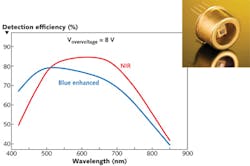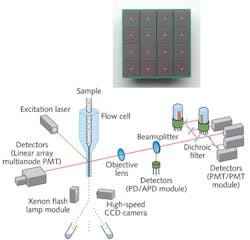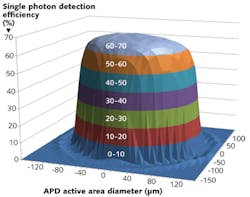Photonics Products: Photodiodes: Silicon low-light photodiodes don't miss a photon
The photodiode, a semiconductor-based solid-state light-measurement device, is typically compact, efficient, and rugged—three traits that make photonics engineers especially happy. (A fourth trait—low cost—is sometimes also on tap, depending on the application.)
Photodiodes produce electron-hole pairs from absorbed photons; the resulting photocurrent is used to characterize the incident light. In addition to the photocurrent, an intrinsic dark current is produced even when no light is hitting the detector; the dark current is an important factor in low-light measurements. Photodiodes having a p-i-n (also termed PIN) junction typically have a faster response then those with a p-n junction.
Many different semiconductors can be used as the basis for photodiodes, with silicon (Si), indium gallium arsenide (InGaAs), and gallium nitride (GaN) being three common materials. Each material has its own wavelength range, with the long-wave cutoff determined by the material's bandgap. For example, GaN has a room-temperature bandgap of 3.4 eV (365 nm); InGaAs can range from 1.42 to 0.34 eV (870 nm to 3.6 μm) depending on the mix; and Si has a bandgap of 1.1 eV (1.1 μm). Thus, GaN is used in the UV and Si in the near-UV to just beyond the visible; InGaAs is commonly used in the near-IR.
Because covering the many types of photodiodes available would require writing a book, this article narrows the field to just one photodiode material (Si) and one very important application: low-light sensing.
APDs and SiPMs
The avalanche photodiode (APD) is at the heart of many low-light-measurement devices and systems. They can be operated in a linear mode or, for single-photon sensitivity, above the device's breakdown voltage, in what is called the Geiger mode. Many APDs operating in the Geiger mode can be combined into a rectangular array to form a so-called silicon photomultiplier (SiPM), which competes with traditional (non-semiconductor-based) photomultiplier tubes (PMTs) in many low-light applications.
Wade Appleman, VP sales and marketing at SensL (Lexington, MA), notes that, in his opinion, the market for low-light sensing is settling into some broad technical categories that are widely recognized (see Table 1).
SensL supplies SiPMs in many forms, including surface-mount micro-leadframe (MLP) styles and active detector sizes that include 1×1, 3×3, and 6×6 mm2 areas, notes Appleman. The newest SiPM from SensL, the C-Series, was launched in August 2014 and has a spectral range from 300 to 800 nm; its peak photon-detection efficiency (PDE) is 41% at 420 nm.
The C-Series devices have very low dark noise, says Appleman, with dark-count rates of < 100 kHz per mm2. Other characteristics include an output uniformity of ±10% with a breakdown voltage falling within a ±250 mV range from device to device.
"SiPMs are used in a wide range of low-light-sensitive applications, including medical imaging, hazard and threat detection, and automotive and industrial lidar," says Appleman. "In medical imaging, the most common application is for use as a detector in nuclear-medicine positron-emission-tomography (PET) scanners, where a full body scanner used in cancer detection may contain more than 30,000 3-mm SiPM detectors. For radiation monitoring and identification, an SiPM can be used in handheld pager-sized devices for isotope identification or in large gantry-type portal scanners used for imaging shipping containers or trucks. In automotive, an increasingly interesting use is in automotive driver assist (ADAS) applications where an SiPM is used in place of a PIN diode or APD because of its better ability to 'see' in bright-light applications and distinguish a smaller returned laser-pulse signal."
Laser Components DG (Phoenix, AZ), which began in-house production of silicon APDs in 2004, produces a series of single-photon APDs that operate over a range of wavelengths from 400 nm to more than 850 nm. The range of devices includes epitaxial and reach-through structures with active area diameters from 230 μm to 3.0 mm, as well as single-photon-counting modules. In a reach-through design, electron multiplication occurs in a thin high-field region, while the incoming photons are absorbed in a much thicker region. An epitaxial design includes additional Si-structure steps that allow fabrication on thick wafers that would otherwise introduce a significant series resistance.
The majority of APDs are packaged individually, but can also be combined with transimpedance amplifiers to create high-speed receivers, says Paul Buettner, sales engineer at Laser Components USA (Hudson, NH). Complete APD modules are also produced that include a temperature-compensated high voltage bias supply.
"These are unique detectors biased at voltages exceeding the device's breakdown and having a very high electric field throughout the structure, therefore allowing a single photon to trigger the avalanche and start the multiplication process," says Dragan Grubisic, GM of Laser Components DG. "However, for a device to be able to detect subsequent photons, the resulting avalanche current needs to be quenched by lowering the bias below the breakdown voltage and then bringing the same bias above the breakdown voltage again. When operated in a single-photon mode, an APD acts as a trigger device, which is a reason why these devices are said to be operated in the Geiger mode."
Laser Components DG produces two types of such low-noise devices optimized for short-wavelength and near-IR ranges (see Fig. 1), as well as a single-photon APD with breakdown voltage as low as 100 V; standard single-photon APDs have breakdown voltages between 300 and 500 V, says Grubisic. He notes that major applications for single-photon APDs include quantum communications, photon-correlated spectroscopy, particle sizing, confocal microscopy, and others.
Tailored response
"Since the avalanche region [of an APD] is designed for the amplification of electrons, there needs to be different solutions for detecting near-IR and blue photons, and this is done by illuminating from the p or the n layer, depending on the wavelength of interest," says Gus Asencios, marketing research manager at Hamamatsu (Bridgewater, NJ). "This type of detector is commonly used when low light levels need to be detected in a very short time, such as [in] pulse scattering." Common applications, he says, include lidar and forward/side-scatter channels in flow-cytometry systems (see Fig. 2).When the light level approaches photon counting, one needs a detector that gives orders-of-magnitude higher gain, but still retains low excess noise. Hamamatsu's multi-pixel photon counter (MPPC; a type of SiPM) detectors have multiple cells connected in parallel acting as one detector, explains Asencios. When operated in Geiger mode, the cells achieve gain of 105 to 106. Individually, they are either on or off, but when connected in parallel, the resulting output would be representative of how many cells are on, which gives an accurate readout of photons detected.
"For ultralow-level detection, dark counts are a major contributor to the decrease of signal-to-noise ratio (SNR), but in this detector, not all dark counts are due to thermal excitation; some are due to optical crosstalk and afterpulse," says Asencios. These two other factors are more evident as the reverse voltage is increased, and if they increase at a higher rate than the avalanche probability, then the SNR will suffer.
"Having an MPPC with low dark counts at a wider reverse-voltage range will increase the SNR of the measurement, as well as enabling wider environmental temperature operation, which is an important benefit for portable instruments," notes Asencios. "In radiation pagers, for example, this lower dark count enables better energy resolution, as well as better sensitivity when used with larger scintillators or low-efficiency scintillators. The relative stability of the dark current over a wide temperature range enables the systems to be used without active temperature control in portable devices."
Excelitas Technologies (Waltham, MA) produces compact (TO-8 can) hermetically sealed APDs with either Si or InGaAs as a semiconductor material; the two spectral responses complement each other, with Si being 400 to 1100 nm and InGaAs neighboring at 100 to 1700 nm. Modifications to the basic devices can include bandwidth and gain optimization.
The company also makes a single-photon-counting module that operates over the 400 to 1060 nm range; the Si APDs used in the module are unique, says Excelitas, in that they have a circular area (180 μm diameter), delivering high uniformity over the active area while achieving a peak photon-detection efficiency of greater than 70% at 700 nm (see Fig. 3). The device is also compliant with the European Union's RoHS Directive 2011/65/EU. Applications for this photon-counting module range from astronomical observation to adaptive optics to ultrasensitive fluorescence detection, among other applications shared by the industry.Discrete amplification
Amplification Technologies (Paramus, NJ) takes its own approach to the SiPM, making what is called a discrete-amplification photon detector (DAPD), in which low-level electrical signal from the individual photodiodes are internally amplified in separate "microchannels" to a precisely determined level and then combined into one analog output signal.
The discrete-amplification approach avoids some traditional trade-offs such as that of high photon detection efficiency versus wide dynamic range, notes Rafael Ben-Michael, Amplification Technologies' CTO. The spectral sensitivity of a DAPD can be customized using the appropriate antireflection coating either for a particular wavelength range, for the highest detection efficiency, or for the whole spectral range.
The DAPD provides very fast time response as well as high gain-bandwidth product, which is a prerequisite for the high-speed detection of low-level signals, says Ben-Michael. For example, the single-electron-response pulse for a DAPD with a 1-mm-diameter active area shows a pulse duration of approximately 1.4 ns full width at half maximum (FWHM) at a gain level of 2.8 x 105. In addition, timing resolution for a series of pulses is 300 ps or less FWHM.
At the heart of discrete amplification is the binary type of amplification in separate channels, which leads to a typical excess noise factor (a measurement of avalanche amplification noise) of less than 1.05 at room temperature for the company's DAPD10C photodetector; this excess noise level is less than occurs even in the operation of the best cryogenic single-photon detectors, says Ben-Michael. As a result, the number of photons in an individual signal pulse can be counted with high accuracy.
The numerous manufacturers of Si-based low-light-detection devices such as SiPMs and single APDs all have their own versions of the technology; the distinctions between various devices can be complex and are finally determined only after careful research based on the particular application that needs to be filled. And thrown into the mix is the non-photodiode-based PMT, which still remains a primary contender for many uses.
For More Information
Companies mentioned in this article include:
Amplification Technologies
Paramus, NJ
www.amplificationtechnologies.com
Excelitas
Waltham, MA
www.excelitas.com
Hamamatsu
Bridgewater, NJ
www.hamamatsu.com
Laser Components
Phoenix, AZ
www.lasercomponents.com
SensL
Lexington, MA
www.sensl.com
For a complete listing of companies making silicon low-light photodiodes, visit the Laser Focus World Buyers Guide (http://buyersguide.laserfocusworld.com/index.html).

John Wallace | Senior Technical Editor (1998-2022)
John Wallace was with Laser Focus World for nearly 25 years, retiring in late June 2022. He obtained a bachelor's degree in mechanical engineering and physics at Rutgers University and a master's in optical engineering at the University of Rochester. Before becoming an editor, John worked as an engineer at RCA, Exxon, Eastman Kodak, and GCA Corporation.



